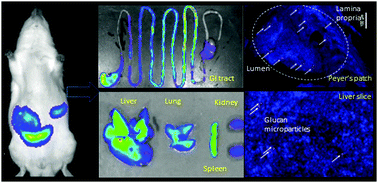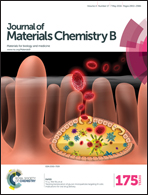Tracking translocation of glucan microparticles targeting M cells: implications for oral drug delivery†
Abstract
Taking advantage of its ability to deal with exogenous pathogens, the M cell passage has proven to be the most reliable pathway for entry of particulates, thus creating opportunities for oral immunization and delivery of biomacromolecules. Albeit a well-known story, the underlying mechanisms of this pathway are not yet well understood, especially concerning direct evidence of translocation of particulates. Herein, model glucan microparticles (GMs) targeting M cells are employed to track translocation through M cell pathways as well as to various organs via the systemic circulation. GMs were first labeled with a novel kind of near-infrared fluorescent water-quenching probe through encapsulation and locking by stearin. In vivo live imaging indicates prolonged residence of GMs in the gastrointestinal tract for as long as 12 h. GMs are found to be gradually absorbed from the ligated ileum segment but little from the jejunum. Histological examination using confocal laser scanning microscopy (CLSM) confirms distribution of GMs to the basolateral side of the ileum through Peyer's patches. However, no detectable fluorescence can be observed in any other organs or tissues until 12 h after administration. After 12 h, GMs can be found in the liver, spleen and lung. At 24 h, GMs accumulate in these organs with approximately 2.3% of the total amount. Repeated administration for three consecutive days augments total accumulation to as high as 4.5%. By tracking GM-bound fluorescence, the particles can be accurately located in these organs. GMs can be transported across Caco-2/Raji and Caco-2/Raji/J774A.1 co-culture monolayers, but not Caco-2 monolayers, in a time-dependent manner. As observed by CLSM, GMs can be voraciously engulfed with as many as 10–15 particles per cell. Evidence of translocation of GMs indicates that GMs can be absorbed through the M cell pathway located at Peyer's patches, especially in the ileum, and translocated to reticulo-endothelial organs.


 Please wait while we load your content...
Please wait while we load your content...